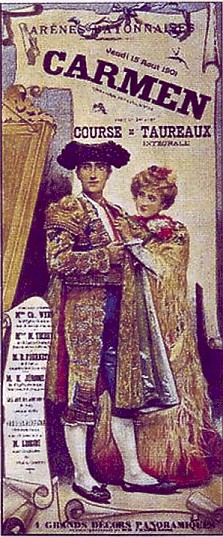Music:
 jhdfkjshdfksjh jhdfkjshdfksjh |
Carmen’s Lunch Break and a Socratic Discourse
By FRANK BEHRENS
ART TIMES Jan/ Feb 2011
After hearing “Carmen” on LPs and then CDs and then watching it on DVDs and in live performances, something finally popped into my mind. Does Carmen sing the Habanera EVERY DAY during the break from the cigarette factory?
There is no doubt that the entire male population of Seville tries its luck with her the moment she appears and that the song is an answer to the crowd. But what should motivate her on that particular day to proclaim her Gypsy Woman’s Manifesto?
Reply: This is only an opera and one does not ask questions like that. The character needs an entrance aria and Bizet gives her a good one. That is all we need to know.
Response: Yes, the work might be an opera but it is also a DRAMA. It is one of the earliest operas that looks at and treats life realistically. These are supposed to be real people and it is up to the Director to make them seem real. If she sings that long song at that moment, there must be some motivation for it.
Reply: There is a motivation. You said so yourself. She is responding to the amorous male chorus.
Response: I thought I covered that. They woo her every day. But why respond on this particular day? What is new that day?
Those familiar with the opera know that Don Jose has just joined the Seville regiment and Carmen sees him for the first time. If I were directing, I would play it this way. Don Jose is busy fixing his firing pin and does not see her. She sees him. Bingo! Her next temporary lover. But how to get his attention? Ah, pretend to be addressing the crowd but aim it all at the handsome soldier.
She sings the first stanza but it doesn’t work. Or perhaps it does but Don Jose pretends not to hear or understand what he clearly does hear. So she becomes bolder. She sings the second stanza directly to him, leaving no doubt to any one as to her intentions. In this way, not only is the song as a whole motivated but even the second stanza alone serves a DRAMATIC purpose — as well as revealing not only her character but her methods.
In fact, I would have her coworkers nudge each other with knowing nods and winks. They certain know what is going on. So should the audience.
And thus can a warhorse of an aria become a telling dramatic event.
Reply: Isn’t that exactly what happens in “La Boheme” when Musetta wins back Marcello with her waltz song?
Response: Yes. Puccini’s librettist knew how to use a song to forward the plot. Bizet’s (I feel) merely put in an entrance number. It is up to the Director to coin gold from the ordinary.
In the next act, we see Escamillo responding to the crowd’s acclaim with his “Toreador Song.” Being a conceited and shallow superstar, his motivation is obvious. He loves being admired and reminds his fans about all the things he has done to be admired. I can believe he DOES sing this song at the drop of a hat whenever he thinks the crowd will appreciate it. However, while singing his aria this time, he notices Carmen. And it is always played on stage that the “amours” at the end of his second stanza are directed only at her, while she repeats them only to him.
Here, only the most obtuse Director would ignore the obvious and treat it as just another aria.
And speaking of “La Boheme,” every single number in that all-too-short gem helps advance the plot as well as revealing character. Oh yes, it has been mentioned that Colline’s farewell to his overcoat seems an interpolation; but it is certainly motivated by the circumstances and does show us quite a bit about Colline’s character — not to mention that of his overcoat!
It is sobering to recall that the earliest musicals scarcely had ANY songs that were dramatically motivated at that moment other than the justification that the character was expressing an emotion concerning events at that moment. Early opera is loaded with this kind of arias, because it was the purpose of an aria back then simply to express a single emotion.
When faced with a “realistic” or “verismo” work from about 1870 on, a Director must find dramatic reasons for nearly every musical moment. WHY is this character singing this particular aria at this moment? What does it accomplish? (That last question might prove unsolvable for many arias.) What new information does it reveal about the character?
This is not easy. But many directors of local opera groups or even professional companies might want to consider this question seriously before mounting yet another humdrum production. But for now, give Carmen a break!
Comments can be made on the ART TIMES facebook page or directly to fbehrens@ne.rr.com
